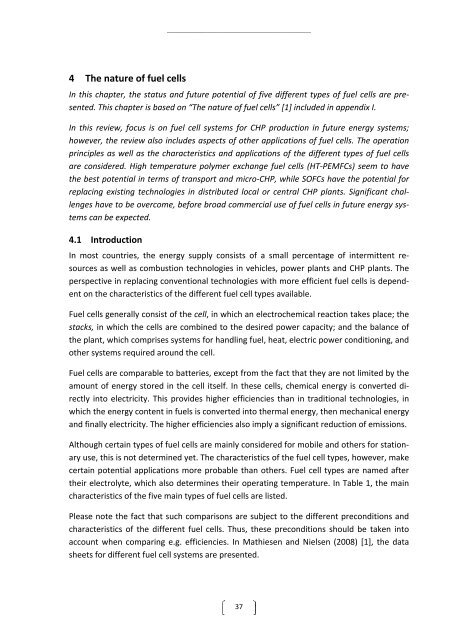Fuel cells and electrolysers in future energy systems - VBN
Fuel cells and electrolysers in future energy systems - VBN
Fuel cells and electrolysers in future energy systems - VBN
You also want an ePaper? Increase the reach of your titles
YUMPU automatically turns print PDFs into web optimized ePapers that Google loves.
4 The nature of fuel <strong>cells</strong><br />
In this chapter, the status <strong>and</strong> <strong>future</strong> potential of five different types of fuel <strong>cells</strong> are pre‐<br />
sented. This chapter is based on “The nature of fuel <strong>cells</strong>” [1] <strong>in</strong>cluded <strong>in</strong> appendix I.<br />
In this review, focus is on fuel cell <strong>systems</strong> for CHP production <strong>in</strong> <strong>future</strong> <strong>energy</strong> <strong>systems</strong>;<br />
however, the review also <strong>in</strong>cludes aspects of other applications of fuel <strong>cells</strong>. The operation<br />
pr<strong>in</strong>ciples as well as the characteristics <strong>and</strong> applications of the different types of fuel <strong>cells</strong><br />
are considered. High temperature polymer exchange fuel <strong>cells</strong> (HT‐PEMFCs) seem to have<br />
the best potential <strong>in</strong> terms of transport <strong>and</strong> micro‐CHP, while SOFCs have the potential for<br />
replac<strong>in</strong>g exist<strong>in</strong>g technologies <strong>in</strong> distributed local or central CHP plants. Significant chal‐<br />
lenges have to be overcome, before broad commercial use of fuel <strong>cells</strong> <strong>in</strong> <strong>future</strong> <strong>energy</strong> sys‐<br />
tems can be expected.<br />
4.1 Introduction<br />
In most countries, the <strong>energy</strong> supply consists of a small percentage of <strong>in</strong>termittent re‐<br />
sources as well as combustion technologies <strong>in</strong> vehicles, power plants <strong>and</strong> CHP plants. The<br />
perspective <strong>in</strong> replac<strong>in</strong>g conventional technologies with more efficient fuel <strong>cells</strong> is depend‐<br />
ent on the characteristics of the different fuel cell types available.<br />
<strong>Fuel</strong> <strong>cells</strong> generally consist of the cell, <strong>in</strong> which an electrochemical reaction takes place; the<br />
stacks, <strong>in</strong> which the <strong>cells</strong> are comb<strong>in</strong>ed to the desired power capacity; <strong>and</strong> the balance of<br />
the plant, which comprises <strong>systems</strong> for h<strong>and</strong>l<strong>in</strong>g fuel, heat, electric power condition<strong>in</strong>g, <strong>and</strong><br />
other <strong>systems</strong> required around the cell.<br />
<strong>Fuel</strong> <strong>cells</strong> are comparable to batteries, except from the fact that they are not limited by the<br />
amount of <strong>energy</strong> stored <strong>in</strong> the cell itself. In these <strong>cells</strong>, chemical <strong>energy</strong> is converted di‐<br />
rectly <strong>in</strong>to electricity. This provides higher efficiencies than <strong>in</strong> traditional technologies, <strong>in</strong><br />
which the <strong>energy</strong> content <strong>in</strong> fuels is converted <strong>in</strong>to thermal <strong>energy</strong>, then mechanical <strong>energy</strong><br />
<strong>and</strong> f<strong>in</strong>ally electricity. The higher efficiencies also imply a significant reduction of emissions.<br />
Although certa<strong>in</strong> types of fuel <strong>cells</strong> are ma<strong>in</strong>ly considered for mobile <strong>and</strong> others for station‐<br />
ary use, this is not determ<strong>in</strong>ed yet. The characteristics of the fuel cell types, however, make<br />
certa<strong>in</strong> potential applications more probable than others. <strong>Fuel</strong> cell types are named after<br />
their electrolyte, which also determ<strong>in</strong>es their operat<strong>in</strong>g temperature. In Table 1, the ma<strong>in</strong><br />
characteristics of the five ma<strong>in</strong> types of fuel <strong>cells</strong> are listed.<br />
Please note the fact that such comparisons are subject to the different preconditions <strong>and</strong><br />
characteristics of the different fuel <strong>cells</strong>. Thus, these preconditions should be taken <strong>in</strong>to<br />
account when compar<strong>in</strong>g e.g. efficiencies. In Mathiesen <strong>and</strong> Nielsen (2008) [1], the data<br />
sheets for different fuel cell <strong>systems</strong> are presented.<br />
37

















